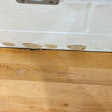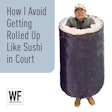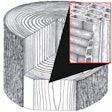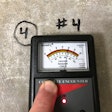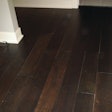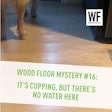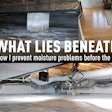Who’s Responsible?
A solid prefinished oak floor I installed ended up cupping, and the inspector blamed the moisture problems on some raised flowerbeds against the foundation. But how can I be responsible for the landscaping? Is this really my problem?
Frank Kroupa, senior director of technical education at the NWFA, answers:
Lots of contractors don’t understand the complexity of our obligations as wood flooring installers. I would estimate that 90 percent of our problems with wood floors are because of moisture. It can come from many different places, and not all of them are obvious. Before we even bring the wood to a job site, we are supposed to examine many things on the outside of the house. For example, we need to check that the gutters are working, check that the ground slopes away from the house, check any window wells and check that sprinklers aren’t pointed at the foundation, to name just a few.
Most of the time any red flags have to be addressed before you proceed. For instance, if the rain gutter is pouring out water right into the foundation, the homeowner (or builder) is supposed to get that fixed before you start the job. If the house backs up right against the side of a mountain, that’s another red flag. Does this mean you can’t put in a wood floor? Of course not, but it does mean you need to take very careful moisture readings in those areas to see if there is a problem.
When checking the moisture readings, you’ll need to compare them against what should be “normal” for that job site and that geographic area. Unfortunately, I think many wood floor contractors are still unfamiliar with moisture meters and hygrometers, but the more you use them correctly and understand what they’re telling you, the better chance you have of avoiding problems like this cupped floor.
Mixing Oil & Water?
Is it OK if I coat over a waterborne sealer with poly?
Steve Crawford, director of sales & marketing at Upper Saddle River, N.J.-based Dura Seal, answers:
A lot of people think you can’t put oil-based poly over water-based poly, or can’t put water over oil-based sealer. Much of that idea comes from when the industry first started formulating water-based finish in the ’70s and ’80s, and they weren’t very good—the resin particles were huge and could bridge the abrasion you put into the previous coat instead of adhering to it. Today’s waterborne finishes have much smaller particle sizes, with tenacious adhesion properties.
To use different types of finishes on the same floor, first, refer to the label directions. For the most part, if the previous coat is clean, dull and dry, the finish will stick to it. Most coatings in our industry require a mechanical bond and, if you create it, generally oil-based finish will stick to water-based finish, and vice versa (when you are talking about traditional polyurethane types of finishes).
When doing this, systems are very important. Typically manufacturers will formulate their finishes to be compatible, even between different finish types. Too often a contractor will have one manufacturer’s stain, another’s sealer that they got a deal on and yet another’s topcoat because that’s what their granddad used. If you get a callback in that situation, who do you call? You’ve probably bought that job. So, read the directions, use products as a system from the same manufacturer and make sure the previous coat is clean, dry and dull. If you’ve got that covered, you’re prepared to get paid and have a satisfied customer.
Slabs & Moisture
Do I always need to use a moisture retarder when working on a slab?
Jeff Meltzer, owner of Universal Hardwood in Los Angeles and an NWFACP-certified flooring inspector, answers:
As the owner of a material supply establishment and inspector, many of the problems I see deal with glue-down installations on concrete. According to the NWFA guidelines, the installer is responsible for job-site conditions. Installers should always test the concrete for moisture using one of several approved testing methods: a calcium chloride test, an RH test, or a calcium carbide (CM) test, which is acceptable but used mostly in Europe.
The results of those tests give you the answer to your question. If testing with calcium chloride reveals moisture levels over 3 lbs. (what is referred to as the Moisture Vapor Emission Rate, or MVER), an RH test reveals levels over 75%, or a CM test has levels over 2.5%, you will need to use some type of moisture retarder. There are many options, among them various underlayments, all-in-one adhesives that include a moisture membrane, two-part epoxies, and moisture barriers that roll on and penetrate the concrete.
Typically, underlayments have different perm ratings, which gives you an idea of how much moisture they allow through them, and products that are spread or rolled onto the slab offer protection up to various pounds of moisture—for example, a product will say something like “warranted for up to 18 lbs.”
Check with the flooring manufacturer (and, if applicable, the adhesive manufacturer) for what they recommend. Every installation has its own particular needs, and the correct selection of moisture mitigation is critical for an installation’s success.




















